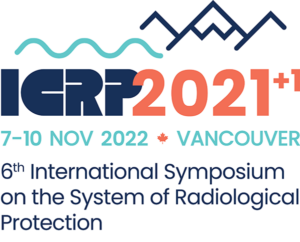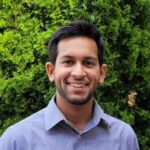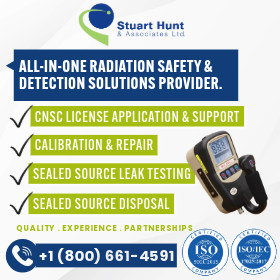L’avenir nous appartient : résumé de la séance de l’ICRP 2021+1 sur la participation des jeunes professionnels
Résumé :
Parmi les séances techniques et scientifiques d’importance au récent congrès ICRP 2021+1 à Vancouver, il y avait une séance qui avait pour objectif stratégique de faire croître le domaine de la radioprotection. Plus précisément, la séance explorait comment nous pouvons faire participer davantage les jeunes à la radioprotection. Avec son coprésident, Mike Boyd, de la United States Environmental Protection Agency, Omar a entrepris d’inviter de jeunes professionnels du monde entier ayant de l’expérience dans différents organismes et sous-domaines, qui pourraient mettre de l’avant leurs idées. Dans cet article, Omar présente les points importants à retenir de la séance selon lui.
 In November 2022, the International Commission on Radiological Protection (ICRP) held its 6th International Symposium on the System of Radiological Protection (aka ICRP 2021+1). The conference, delayed by a year due to the pandemic, was hosted by ICRP in partnership with the Canadian Nuclear Safety Commission (CNSC) and the Canadian Radiation Protection Association (CRPA) in beautiful, snowy Vancouver.
In November 2022, the International Commission on Radiological Protection (ICRP) held its 6th International Symposium on the System of Radiological Protection (aka ICRP 2021+1). The conference, delayed by a year due to the pandemic, was hosted by ICRP in partnership with the Canadian Nuclear Safety Commission (CNSC) and the Canadian Radiation Protection Association (CRPA) in beautiful, snowy Vancouver.
Among sessions of technical and scientific importance, one session was strategically aimed at growing our field. Specifically, the session explored how we can increase the involvement of young people in radiation protection. What are we doing right? Can we do things better?
I was fortunate to have been invited by ICRP to co-chair this session, titled “Involving Young Professionals.” My co-chair, Mike Boyd from the United States Environmental Protection Agency (EPA), and I set out to invite young professionals who could address different aspects of the session’s theme. We were fortunate to have attracted speakers from around the world, with experience in different organizations and subfields, who could bring their ideas to the forefront.
The speakers shared their experiences navigating the radiation protection field as young professionals, and highlighted some of the challenges they faced on their journeys. They also discussed the importance of having younger voices in the field of radiation protection and how those voices can be better supported and encouraged to participate in initiatives like the ICRP Mentorship Programme.
Our speakers shared perspectives on education, mentorship, and maintaining a healthy work-life balance. Here are the presentations and their key takeaways:
- Experiences of One Mentee – the ICRP Mentorship Programme and Beyond
Julie Leblanc, Women in STEM special advisor, Canadian Nuclear Safety Commission (CNSC)
- How to Start a Network? Experience in Networking and Achievements of the International Radiation Protection Association (IRPA) Young Generation Network
Sylvain Andresz, senior researcher, Centre d’étude sur l’évaluation de la protection dans le domaine nucléaire (CEPN)
- Radiation Safety Program for Hybrid Modalities in Canada
Lauren Fougner, radiation safety officer, BC Cancer Research Institute
- Contributing as a Mentee: Diverse Operational Environments within Veterinary Practice and their Challenges for Radiological Protection
Tony Davila, radiation safety officer, Tulane University
- Perspectives from a First-Generation Graduate Student and Researcher in Canada: Surprises, Obstacles, and Other Considerations
Marta Kocemba, PhD student, Nuclear Engineering, Ontario Tech University
Key takeaways:
- Young professionals need support and understanding when they are starting out, especially with respect to maintaining personal and family commitments.
- The ICRP Mentorship programme is a great way for young people to get involved in the international radiation protection community while making scientific contributions.
- Building an international young generation network (YGN) is a difficult but rewarding process; new ideas can be learned and shared among national radiation protection associations and their respective YGNs.
- Radiation protection in often overlooked areas like veterinary medicine should be highlighted when discussing the strengths of our field.
- The rigorous exploration of new ideas like the use of artificial intelligence in radiation protection must be embraced.
- Resources should be in place to ensure first-generation students have opportunities to succeed in this field.
- Effective communication is needed to ensure students are aware of radiation protection as a field and a career.
The session also included a fun Q&A session with the audience in which we discussed ideas about how to best engage science and engineering students to promote radiation protection and safety. The key takeaway here was that social media is the single most important driver of engagement among young people. Therefore, it is imperative that we remain active on all channels, especially on newer platforms like TikTok.
Nuclear power has gained increasing public support in recent years, and in the context of climate change goals like Net-Zero by 2050, it is important that young people know about the importance of radiation protection and the employment opportunities in this field, both now and in the near future.
There are a lot of moving parts involved when organizing a session like this, as it involves working with international invitees, coordinating their travel and accommodations, and making sure the presentations run smoothly. It was a rewarding experience to see the session come together and to witness the energy and enthusiasm that the speakers brought to the event.
Overall, it was an immensely rewarding experience to be a part of ICRP 2021+1 and to witness the passion of the speakers who wanted to ensure young professionals are adequately represented in radiation protection. It was also a great opportunity for me to represent Toronto Metropolitan University and the IRPA YGN. Most importantly, it was a great experience to finally meet with the radiation protection community in person.
Thank you to all attendees for making the session a success, to ICRP, CNSC, and CRPA for hosting, and to our invited panelists for their contributions.
Omar Nusrat

Vous voulez lire d’autres articles comme celui-ci ?
Le Bulletin de l’Association canadienne de la radioprotection (ACRP) est une publication essentielle à tout professionnel de la radioprotection du Canada. Son contenu éditorial procure aux professionnels de la radioprotection les enseignements, l’information, les conseils et les solutions utiles, tous nécessaires pour demeurer à l’avant-garde de la profession.
Abonnez-vous aujourd’hui pour que nous vous envoyions un courriel chaque fois qu’un nouveau numéro est mis en ligne. Revisitez souvent le site entre chaque numéro pour obtenir les mises à jour et consulter de nouveaux articles.
Ne ratez aucun numéro. Abonnez-vous dès aujourd’hui !
Abonnez-vous









